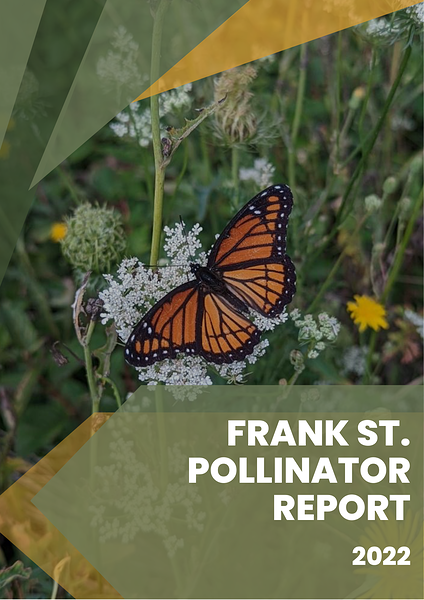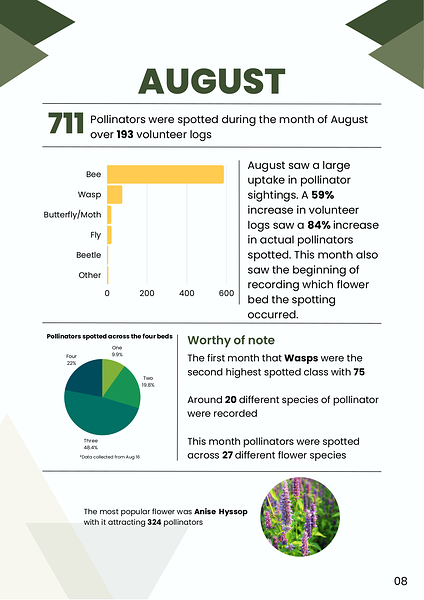Dinah Robinson
The Frank Street Bee and Butterfly Gardens (FSBBG) has discovered which of its flowers are the most popular – with pollinating insects, not people.
The garden launched in 2021, with a mission to provide a beautiful space to build friendships and community, while learning how to support local pollinators and ecosystems. In 2022, it launched a project to log the different pollinators seen in the garden.
Volunteers and people who were passing by the gardens were invited to take pictures and log their sightings in a public datasheet. The research study was advertised on social media and with signage in the gardens. A QR code was created for easy access to the web-based data collection sheet.
The project ran from June to October. The data was analyzed and the 2022 Pollinator Report was released this March, with visual summaries on the monthly visits by insect type and plant activity.
This allowed the group to determine which flowers were most popular, what pollinators visited each of the plants, as well as the number and variety of pollinators by season.
The favourite flowers were: Anise Hyssop, sneezeweed, sunflower, and milkweed.
The project was led by Owen Wady. With a media and communications background, Owen is more comfortable with computers and spreadsheets than gardens. “I’m keen on bugs but not a gardener.” His experience in data collection and stats was just what the FSBBG needed.
No bug experts were involved in the data collection and analysis, just volunteer enthusiasts. The data log ranged from vague entries to very specific reports. Owen reviewed and completed any missing details.
Entries with a description or image attached were researched to confirm species identification. Entries with limited descriptions were categorized as “Bee” or “Wasp.”
Pollinator sightings were captured on 82 separate days, by more than 20 different volunteers. They logged 512 separate entries. A total of 2,162 pollinators were spotted on 49 different types of flowers.
The project also highlighted what might be missing from the gardens. Only three Monarch butterflies were seen in 2022, the year the much-loved migratory beauty was added to the Red List of Threatened Species. Very few butterflies were observed throughout the project.
Butterflies need two different types of plants for survival: nectar plants for food and a host plant where they can lay their eggs. The eggs become hungry caterpillars that need to eat leaves from the plant they live on while growing and transforming into butterflies. It can’t just be any plant. Some, like the Monarch, can consume just one type of plant. Only milkweed has the right mix of nutrients for this specialist.
For generalist butterflies, there are a few different plants that can serve as host, but the list is usually short. They still need to rely on plants within the same family. Adult butterflies prefer pink, white, and purple flowers. They like a flat surface that can act as a landing pad or clusters of small flowers where they can access lots of nectar without moving around and wasting energy.
Carlos Murray started the FSBBG and heads its gardening committee. He said the report is “only a micro-image of the Frank at Bank Street (pollinator) activity. More data collection is required.”
There’s a lot of pavement in Centretown that could be torn up to convert into greenspace. “Taking advantage of these (underutilized) spaces is a great way to increase greenspace and provide habitat”, Carlos commented. Creating connected corridors is a key aspect of pollinator protection. Which garden will the butterflies visit next?
The team at the FSBBG also has a list of the native plants in their garden, with details on the characteristics and flowering times. The gardens had 67 native plants and 31 non-native species in a 166m2 area. The group will continue to plant native species as the donations come in. There’s even an expansion opportunity into the garden boxes at the apartment building across the street, perhaps with a special focus on butterfly habitat.
There are plans to repeat the data collection process in 2023, with a newly formed Science and Data committee. They’re looking into making the pollinator tracking more streamlined and helping with pollinator identification.
When asked why he joined the project, Owen said, “I had a fear of butterflies, and I made a New Year’s resolution to face down the butterfly fear.” Given the poor butterfly turn-out in 2022, another season of data collection, with new butterfly-favourite flowers, is definitely needed.
The complete Pollinator Data Tracking report can be found on the FSBBG website: ray673294.wixsite.com/frankstbbg/data-reports



1 comment for “Which flowers are the most popular – with pollinators?”